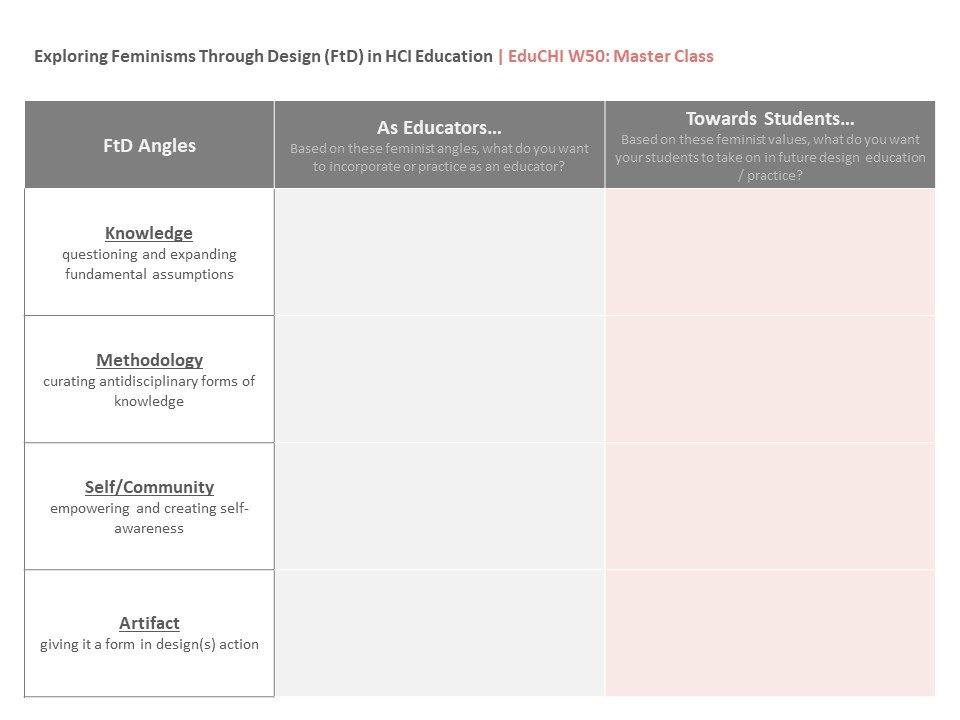Feminisms through Design
I engage in the theoretical construct of “Feminisms” in HCI and design to frame my teaching practice, speculate research engagements, and re-evaluate HCI research trajectory. I have published in that space and share my framework of FtD (Feminisms through Design).
FtD: Feminisms through Design
This article represents my reflection on feminism and design. Its goal is to provoke your own feminist position on design and help you to navigate this space through understanding the feminist values embedded in design. I present a practical proposal for feminisms through design (FtD) for various audiences- researchers, practitioners, and educators {T2}.
Exploring Feminisms Through Design in HCI Education
Designed a Master Class for HCI educators and researchers on “Exploring Feminisms through Design in HCI Education” at the EduCHI Symposium at 2022 CHI Conference on Human Factors in Computing Systems. The FtD worksheet provides a template or structure for the educators to describe, imagine, and evaluate their curriculum design and teaching philosophies.
Bardzell's "Feminist HCI" Legacy: Analyzing Citational Patterns
In this late-breaking work, we describe the legacy of feminist theory within HCI literature, focusing on Shaowen Bardzell's seminal publication "Feminist HCI: Taking Stock and Outlining an Agenda for Design," which was one of the first to propose adoption of feminist theories into HCI research and practice. We conducted a citation analysis of 70 published texts that cited this paper, using the Harwood functions to identify how feminist theory concepts have been cited in HCI and whether the implementation of proposed frameworks has taken place. This paper was mostly given 'credit,' and most frequently 'signposted' to keep readers on track of the topical issues in HCI, with little evidence of explicit use or extension of proposed frameworks. These results demonstrate a largely one-dimensional impact, characterized by a lack of deep engagement in feminist theories. We identify opportunities to expand feminist approach to further improve research and practice in HCI. {E4}
Cultural Diversity as a design precedent: A (Feminist) Angle to HCI/d Expansion
Various forms of design knowledge have been discussed such as methods, schemas, precedents, etc. In this chapter, I discuss cultural history, knowledge, interactions, and roots of researchers and designers as a design precedent. I talk through this concept as I present various case studies where researchers have built their research agenda heavily drawing from their cultural background. I discuss how framing their research agendas using cultural precedents enabled expansion of the power of design, especially in the field of Human-Computer Interaction (HCI). I highly relate to this space due to my personal researcher positionality as a “foreign cultural entity” in the westernized HCI theory. The case studies presented showcase how researchers and designers used cultural knowledge to frame their research methods, tools, outcomes, and philosophy. I further discuss this intake of cultural perspectives as a precedent for HCI research and design practice: 1) For expanding scope of criticality in HCI design spaces and in turn, 2) Promoting Feminisms of thought through the diversity cultural knowledge and background entails in design work, with the risk of multiple perspectives fighting with each other; and 3) Encouraging cross-pollination of ideas to build the larger research agenda for HCI design.
I also intend to use this chapter as a self-reflection and an avenue to represent young researchers who have excelled in the space of connecting HCI and design spaces to various dimensions through their cultural underpinnings.



